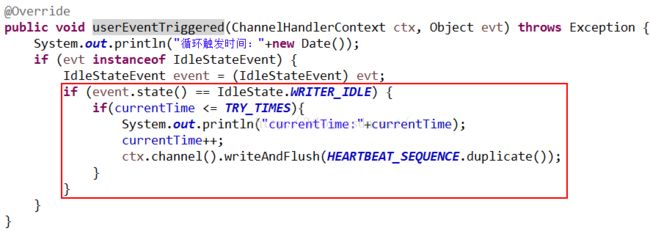一起学Netty(十二)之 Netty心跳简单Demo
前面简单地了解了一下IdleStateHandler,我们现在写一个简单的心跳demo:
1)服务器端每隔5秒检测服务器端的读超时,如果5秒没有接受到客户端的写请求,也就说服务器端5秒没有收到读事件,则视为一次超时
2)如果超时二次则说明连接处于不活跃的状态,关闭ServerChannel
3)客户端每隔4秒发送一些写请求,这个请求相当于一次心跳包,告之服务器端:客户端仍旧活着
我们开始先开始写服务器端的handler,继承ChannelInboundHandlerAdapter,我们先重写userEventTriggered方法,这个方法我们前面讲过,如果超时则会触发相应的超时事件
HeartBeatServerHandler.java
package com.lyncc.netty.heartbeats;
import io.netty.channel.ChannelHandlerContext;
import io.netty.channel.ChannelInboundHandlerAdapter;
import io.netty.handler.timeout.IdleState;
import io.netty.handler.timeout.IdleStateEvent;
public class HeartBeatServerHandler extends ChannelInboundHandlerAdapter {
private int loss_connect_time = 0;
@Override
public void userEventTriggered(ChannelHandlerContext ctx, Object evt) throws Exception {
if (evt instanceof IdleStateEvent) {
IdleStateEvent event = (IdleStateEvent) evt;
if (event.state() == IdleState.READER_IDLE) {
loss_connect_time++;
System.out.println("5 秒没有接收到客户端的信息了");
if (loss_connect_time > 2) {
System.out.println("关闭这个不活跃的channel");
ctx.channel().close();
}
}
} else {
super.userEventTriggered(ctx, evt);
}
}
@Override
public void channelRead(ChannelHandlerContext ctx, Object msg) throws Exception {
System.out.println("server channelRead..");
System.out.println(ctx.channel().remoteAddress() + "->Server :" + msg.toString());
}
@Override
public void exceptionCaught(ChannelHandlerContext ctx, Throwable cause) throws Exception {
cause.printStackTrace();
ctx.close();
}
}
再写一下服务器端,我们要注意的是,我们要在channelPipeline中加入IdleStateHandler,我们在handler中提示的是5秒读,所以我们配置的是:
![]()
这样就可以每隔5秒检测一下服务端的读超时。完整代码清单如下:
package com.lyncc.netty.heartbeats;
import io.netty.bootstrap.ServerBootstrap;
import io.netty.channel.ChannelFuture;
import io.netty.channel.ChannelInitializer;
import io.netty.channel.ChannelOption;
import io.netty.channel.EventLoopGroup;
import io.netty.channel.nio.NioEventLoopGroup;
import io.netty.channel.socket.SocketChannel;
import io.netty.channel.socket.nio.NioServerSocketChannel;
import io.netty.handler.codec.string.StringDecoder;
import io.netty.handler.codec.string.StringEncoder;
import io.netty.handler.logging.LogLevel;
import io.netty.handler.logging.LoggingHandler;
import io.netty.handler.timeout.IdleStateHandler;
import java.net.InetSocketAddress;
import java.util.concurrent.TimeUnit;
public class HeartBeatServer {
private int port;
public HeartBeatServer(int port) {
this.port = port;
}
public void start(){
EventLoopGroup bossGroup = new NioEventLoopGroup(1);
EventLoopGroup workerGroup = new NioEventLoopGroup();
try {
ServerBootstrap sbs = new ServerBootstrap().group(bossGroup,workerGroup).channel(NioServerSocketChannel.class).handler(new LoggingHandler(LogLevel.INFO)).localAddress(new InetSocketAddress(port))
.childHandler(new ChannelInitializer() {
protected void initChannel(SocketChannel ch) throws Exception {
ch.pipeline().addLast(new IdleStateHandler(5, 0, 0, TimeUnit.SECONDS));
ch.pipeline().addLast("decoder", new StringDecoder());
ch.pipeline().addLast("encoder", new StringEncoder());
ch.pipeline().addLast(new HeartBeatServerHandler());
};
}).option(ChannelOption.SO_BACKLOG, 128)
.childOption(ChannelOption.SO_KEEPALIVE, true);
// 绑定端口,开始接收进来的连接
ChannelFuture future = sbs.bind(port).sync();
System.out.println("Server start listen at " + port );
future.channel().closeFuture().sync();
} catch (Exception e) {
bossGroup.shutdownGracefully();
workerGroup.shutdownGracefully();
}
}
public static void main(String[] args) throws Exception {
int port;
if (args.length > 0) {
port = Integer.parseInt(args[0]);
} else {
port = 8080;
}
new HeartBeatServer(port).start();
}
}
也就说这个方法每隔4秒都能触发:
红色边框代码在客户端没有写事件的时候,一超时就会触发写请求:
完整代码如下:
HeartBeatClientHandler.java
package com.lyncc.netty.heartbeats;
import java.util.Date;
import io.netty.buffer.ByteBuf;
import io.netty.buffer.Unpooled;
import io.netty.channel.ChannelHandlerContext;
import io.netty.channel.ChannelInboundHandlerAdapter;
import io.netty.handler.timeout.IdleState;
import io.netty.handler.timeout.IdleStateEvent;
import io.netty.util.CharsetUtil;
import io.netty.util.ReferenceCountUtil;
public class HeartBeatClientHandler extends ChannelInboundHandlerAdapter {
private static final ByteBuf HEARTBEAT_SEQUENCE = Unpooled.unreleasableBuffer(Unpooled.copiedBuffer("Heartbeat",
CharsetUtil.UTF_8));
private static final int TRY_TIMES = 3;
private int currentTime = 0;
@Override
public void channelActive(ChannelHandlerContext ctx) throws Exception {
System.out.println("激活时间是:"+new Date());
System.out.println("HeartBeatClientHandler channelActive");
ctx.fireChannelActive();
}
@Override
public void channelInactive(ChannelHandlerContext ctx) throws Exception {
System.out.println("停止时间是:"+new Date());
System.out.println("HeartBeatClientHandler channelInactive");
}
@Override
public void userEventTriggered(ChannelHandlerContext ctx, Object evt) throws Exception {
System.out.println("循环触发时间:"+new Date());
if (evt instanceof IdleStateEvent) {
IdleStateEvent event = (IdleStateEvent) evt;
if (event.state() == IdleState.WRITER_IDLE) {
if(currentTime <= TRY_TIMES){
System.out.println("currentTime:"+currentTime);
currentTime++;
ctx.channel().writeAndFlush(HEARTBEAT_SEQUENCE.duplicate());
}
}
}
}
@Override
public void channelRead(ChannelHandlerContext ctx, Object msg) throws Exception {
String message = (String) msg;
System.out.println(message);
if (message.equals("Heartbeat")) {
ctx.write("has read message from server");
ctx.flush();
}
ReferenceCountUtil.release(msg);
}
}
客户端代码也要加入IdleStateHandler这个handler,注意的是,我们要注意的是写超时,所以要设置写超时的时间,因为服务器端是5秒检测读超时,所以客户端必须在5秒内发送一次心跳,告之服务端,所以我们设置4秒:
![]()
完整代码如下:
package com.lyncc.netty.heartbeats;
import java.util.concurrent.TimeUnit;
import io.netty.bootstrap.Bootstrap;
import io.netty.channel.ChannelFuture;
import io.netty.channel.ChannelInitializer;
import io.netty.channel.ChannelOption;
import io.netty.channel.ChannelPipeline;
import io.netty.channel.EventLoopGroup;
import io.netty.channel.nio.NioEventLoopGroup;
import io.netty.channel.socket.SocketChannel;
import io.netty.channel.socket.nio.NioSocketChannel;
import io.netty.handler.codec.string.StringDecoder;
import io.netty.handler.codec.string.StringEncoder;
import io.netty.handler.logging.LogLevel;
import io.netty.handler.logging.LoggingHandler;
import io.netty.handler.timeout.IdleStateHandler;
public class HeartBeatsClient {
public void connect(int port, String host) throws Exception {
// Configure the client.
EventLoopGroup group = new NioEventLoopGroup();
try {
Bootstrap b = new Bootstrap();
b.group(group)
.channel(NioSocketChannel.class)
.option(ChannelOption.TCP_NODELAY, true)
.handler(new LoggingHandler(LogLevel.INFO))
.handler(new ChannelInitializer() {
@Override
public void initChannel(SocketChannel ch) throws Exception {
ChannelPipeline p = ch.pipeline();
p.addLast("ping", new IdleStateHandler(0, 4, 0, TimeUnit.SECONDS));
p.addLast("decoder", new StringDecoder());
p.addLast("encoder", new StringEncoder());
p.addLast(new HeartBeatClientHandler());
}
});
ChannelFuture future = b.connect(host, port).sync();
future.channel().closeFuture().sync();
} finally {
group.shutdownGracefully();
}
}
/**
* @param args
* @throws Exception
*/
public static void main(String[] args) throws Exception {
int port = 8080;
if (args != null && args.length > 0) {
try {
port = Integer.valueOf(args[0]);
} catch (NumberFormatException e) {
// 采用默认值
}
}
new HeartBeatsClient().connect(port, "127.0.0.1");
}
}
我们先启动服务器端:
再启动客户端:
此时客户端还存活着,我们看看服务器端的输出:
我们再看看客户端的输出:
inactive的事件触发了,且客户端自动停止了~
简单的心跳Demo就是这样,如有不对,还希望大家多多拍砖~




